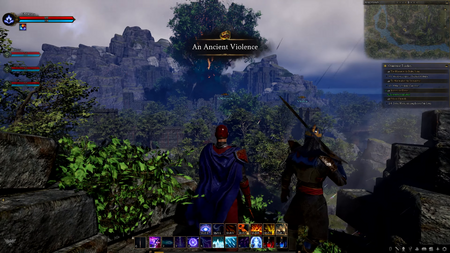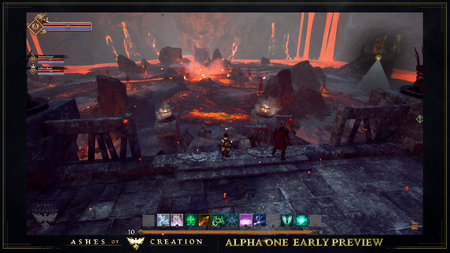Dungeon difficulty
La difficulté du contenu JcE, tel que les raids et les dongeons, s'adaptera sur la base de la performance du raid du groupe contre les bosses précédents dans cette confrontation.[1]
- Une performance élevée dans les premières phases de la confrontation augmentera la difficulté des phases suivantes.[1]
- Plus élevée est la difficulté, meilleures seront les tables de butin.[1]
- Les Bosses et monstres se seront pas calibrés automatiquement sur la base de la taille du groupe.[2]
Level scaling
Levels, stats, or skills will not be scaled to allow low level players to participate in encounters with higher level players or world bosses.[3][4][5]
- Q: Will world bosses scale when it comes to player levels and is it based on players or the zone itself leveling?
- A: They will not scale based on player level, no.[3] – Steven Sharif
Contenu adaptatif
Des nouveaux points d'intérêt (tel que des donjons et des Bosses d'extérieur) apparaissent à mesure que les Nœuds avancent.[6] Le contenu s'adapte au développement de la zone dans lequel il se trouve.[7]
- Les Populations changeront.[7]
- La difficulté du contenu changera.[7]
- Le contenu lui-même peut être complètement différent, selon ce qui est développé et comment.[7]
- Différents types d'adversaires avec différentes histoires.[7]
- Certains donjons ne se déverrouilleront que si les nœuds sont développés jusqu'à certaines étapes.[8]
- Les objectifs d'histoires pour les joueurs à l'intérieur d'un donjon dépendront des chemins narratifs choisis à travers le système de nœud.[8]
- Les Tables de butins dans les zones et dans les donjons seront liées à la progression dans certaines zones.[8]
Certains donjons et autres points d'intérêt sur la carte vont être affectés par le développement des nœuds sur le serveur. Certains donjons ne seront déverrouillés que si les nœuds sont développés jusqu'à certaines étapes. Les objectifs d'histoires pour les joueurs à l'intérieur d'un donjon dépendront des chemins narratifs choisis à travers le système de nœud. Les Tables de butins dans les zones et dans les donjons seront liées à la progression dans certaines zones. Par exemple, admettons que les humains aient développé un nœud dans la Région A, et une histoire s'est ouverte et dirige les joueurs pour qu'ils inspectent les ruines (donjon) d'une zone proche. Et admettons que ce nœud se soit développé en tant que nœud scientifique (artisanat)… Eh bien avant que ce nœud ait été développé, ce donjon était accessible… Mais maintenant le donjon a propagé des nouveaux objets et monstres qui incluent des tables de butin qui répondront à des besoins d'artisanat grâce au développement de ce nœud scientifique. Et peut être qu'un nouveau boss apparaîtra dans différentes pièces du donjon qui inclura des différents départs de quêtes et d'aventures, comme un objet mystérieux avec une histoire propre qui ne peut être avancée que si un nœud s'est développé jusqu'au statut de métropole dans certaines régions, à travers la planète. Notre système est tellement vaste, quand il s'agit d'interconnectivité et de la manière dont le monde réagit aux joueurs.[8]
Dungeon size
L'intention est que les donjons vont être 'massifs' à grande échelle.[10]
- Cavernes massives et espace en monde ouvert.[10]
- Des endroits pour convenir à des engagements plus grands et plus petits.[10]
- Où les personnes avec 30 minutes peuvent participer.
- Les donjons sont vastes et ont de la place pour plusieurs groupes.[11]
Loot tagging
Looting rights (also known as Loot tagging) is based on a blended tag and damage done system.[12][13]
- The first party to obtain a tag (on a mob or boss) will gain an approximately 5-10% edge over competing parties in terms of the total damage done when determining looting rights.[12][13]
- These numbers will be balanced based on testing.[12]
- At the end of the fight, the party with the highest damage done, including first tagging bonus, will be granted looting rights.[12][13]
- We have a blended approach of damage done and a tag benefit. So if you tag the boss first, or you tag the loot- whatever the loot target is first- you're gonna get a benefit in the damage overall determination. So if you need to have 51% of damage done in order to qualify your raid, or the plurality of damage done if there's even three or four raids, then tagging first might give you a five or ten percent edge. We'll play with that number- balance it based on testing, but generally that's our approach in competing loot rights[12] – Steven Sharif
- Q: If looting rights are based on a blended tag and damage done system, will there be any mechanics in place to ensure roles like tanks and healers have an equal shot even when they haven't dealt as much damage?
- A: That's the reason for the blended approach. The reason that we're doing a hybrid system between tag and damage done is for the purposes of those classes who may not be as DPS oriented as other classes. The tag system- all classes are going to have a sprinkling of immediate effects- of instantaneous casts and they can use that to tag a target, and that'll give them a modifier on the looting rights: So plus 10 or plus 15 will balance that, but it'll give them plus 10 to 15 on overall damage done if they tag the target and then their damage will make up the remainder of that percentage completion. So if I do 50 damage to a target but someone else has the tag I'm not going to be able to claim that looting right. They'll have done the other 50 plus 10 or 15.[14] – Steven Sharif
Group sizes

We're not creating a solo game, but it doesn't mean that we don't offer gameplay that is solo centric as well: It lives in addition to the social aspect of What MMOs provide; and so part of what we do in order to to give that element of gameplay is we have quest lines that are devoted towards solo players. We have hunting grounds. Obviously one of the benefits of being a solo player is you get to keep everything that drops. You don't have to share loot with a party or with friends; that's one benefit of being a solo player. But it's going to be more difficult to overcome challenges; and those individuals who are up to taking that additional level of of difficulty are going to excel perhaps in their character progression a bit faster than those who are more group-centric. It's going to be a little bit of a roll of the dice there because there are loot tables, there are reward tables that accompany that, but it's important to note that from a content perspective Ashes of Creation is looking to fulfill both that solo-oriented mind in gameplay as well as the group and social experience; and a lot of times those paths diverge: They move apart, they come back together; and that process is going to be seen throughout the leveling in Ashes of Creation where you'll have more opportunities for solo gameplay and some opportunities for group gameplay.[16] – Steven Sharif
Ashes of Creation is designed for solo players as well as large and small groups.[16][17][18]
- The idea behind an 8-person group is to allow us to really amplify party roles, and to create a need for each of the archetypes in every party.[19]
- Raids will have 40 man groups.[20]
- Content will be tailored for 40, 16 and 8 person group sizes.[21]
- Arènes will have 1 man, 3 man, 5 man and possibly 20 man Free-For-All (Deathmatch) group sizes.[22]
- Siège de Château are expected to have at minimum 250x250 players to be on a single battlefield, with the possibility of increasing this to 500x500 over time.[24][25][26][27]
- The minimum goal is 500 players on a single battlefield. I think we will be able to hit 500vs500 but we shall see.[27] – Steven Sharif
Solo players
Ashes of Creation provides gameplay options for solo oriented players.[16]
- For those solo players who don't really care about finding a community to play with but they want to have one when they need it, there's going to be a lot of opportunities from a dialogue perspective, in-game chat options; you can join as part of citizenships: there's a lot of pseudo factions there- social organizations that give you an in to other players without the strong bonds that typically come with guild-oriented organizations; and I think that that's a comfortable medium between the two.[16] – Steven Sharif
- Certain quest lines and hunting grounds are devoted towards solo players.[16][29]
- Node citizenship and social organizations provide the ability to interact without the strong bonds that typically come with guild-oriented organizations.[16][30]
- Mechanics exist within larger conflicts for small groups and solo players to impact the battle.[31]
- This includes systems that will likely focus on single group sized participants while the larger battle is occurring.[31]
Mentor program
There will be a mentorship program where upper-level players are able to benefit from partying and/or helping lower level players; and getting them situated in the game.[5]
- Certain node buildings and organizations offer quests that can be initiated by a mentor to assist new players. Rewards are offered to both the mentor and the mentee upon completion.[32]
- There will be activities that are present for higher level players to mentor lower level players. Let's say you have a friend who joins later on and you still want to do things with them, there will be things to do. Will he be able to enter a dungeon of your level and participate? No, because we don't want to inflate or deflate characters and manipulate that type of skill or power. We want that to be something that makes sense for them in a progression standpoint.[33] – Steven Sharif
- The mentorship program provides individual quests that can be initiated by the mentor based off of what node that they are part of. So these are like quests that are determined by either certain buildings and/or organizations or the mayor; and there are specific ones that are available for mentors to provide mentees; and they can also participate in some of those quest lines as well: Whether that be leading your mentee through a dungeon or providing a location for them to arrive with you at, or escort quests for the NPC caravans. These types of things, when done together with your mentor, will provide benefits both for the mentor and the mentee as well, so you're incentivized to participate with new players.[32] – Steven Sharif
Voir également
Les références
- ↑ 1.0 1.1 1.2 Entrevue, 2020-07-19 (14:51).
- ↑ Entrevue, 2020-07-19 (17:12).
- ↑ 3.0 3.1 Direct, 2023-05-31 (43:55).
- ↑ Entrevue, 2021-06-13 (24:14).
- ↑ 5.0 5.1 Vidéo, 2018-04-05 (40:08).
- ↑ Direct, 2017-11-17 (36:22).
- ↑ 7.0 7.1 7.2 7.3 7.4 Direct, 2017-11-17 (18:29).
- ↑ 8.0 8.1 8.2 8.3 MMOGames interview, January 2017
- ↑ Direct, 2020-03-28 (1:53:18).
- ↑ 10.0 10.1 10.2 Direct, 2017-05-19 (23:00).
- ↑ Direct, 2018-02-09 (45:30).
- ↑ 12.0 12.1 12.2 12.3 12.4 Direct, 2022-03-31 (1:23:06).
- ↑ 13.0 13.1 13.2 Direct, 2020-07-25 (1:24:56).
- ↑ Direct, 2022-06-30 (1:16:22).
- ↑ Vidéo, 2024-02-29 (33:57).
- ↑ 16.0 16.1 16.2 16.3 16.4 16.5 Direct, 2022-09-30 (2:40).
- ↑ Direct, 2020-11-30 (1:20:25).
- ↑

- ↑ 19.0 19.1 Group dynamics blog.
- ↑ Direct, 2017-05-09 (34:38).
- ↑ February 8, 2019 - Questions and Answers.
- ↑

- ↑ Direct, 2017-05-26 (48:12).
- ↑ Direct, 2021-09-24 (52:48).
- ↑ Entrevue, 2021-07-08 (57:19).
- ↑ Entrevue, 2020-07-19 (44:28).
- ↑ 27.0 27.1

- ↑ Vidéo, 2022-09-30 (23:13).
- ↑ About Ashes of Creation.
- ↑ Direct, 2017-05-08 (28:48).
- ↑ 31.0 31.1

- ↑ 32.0 32.1 32.2 32.3 32.4 Direct, 2020-09-30 (1:07:22).
- ↑ Entrevue, 2018-08-24 (8:52).

